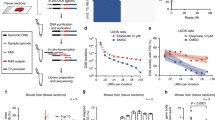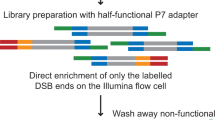Abstract
Here, we present two approaches to map DNA double-strand breaks (DSBs) and single-strand breaks (SSBs) in the genome of human cells. We named these methods respectively DSB-Seq and SSB-Seq. We tested the DSB and SSB-Seq in HCT1116, human colon cancer cells, and validated the results using the topoisomerase 2 (Top2)-poisoning agent etoposide (ETO). These methods are powerful tools for the direct detection of the physiological and pathological “breakome” of the DNA in human cells.
Similar content being viewed by others
References
Iacovoni JS et al (2010) High-resolution profiling of gammaH2AX around DNA double strand breaks in the mammalian genome. EMBO J 29(8):1446–1457
Blitzblau HG, Hochwagen A (2011) Genome-wide detection of meiotic DNA double-strand break hotspots using single-stranded DNA. Methods Mol Biol 745:47–63
Hu J et al (2016) Detecting DNA double-stranded breaks in mammalian genomes by linear amplification-mediated high-throughput genome-wide translocation sequencing. Nat Protoc 11(5):853–871
Klein IA et al (2011) Translocation-capture sequencing reveals the extent and nature of chromosomal rearrangements in B lymphocytes. Cell 147(1):95–106
Chiarle R et al (2011) Genome-wide translocation sequencing reveals mechanisms of chromosome breaks and rearrangements in B cells. Cell 147(1):107–119
Tsai SQ et al (2015) GUIDE-seq enables genome-wide profiling of off-target cleavage by CRISPR-Cas nucleases. Nat Biotechnol 33(2):187–197
Wang XL et al (2015) Unbiased detection of off-target cleavage by CRISPR-Cas9 and TALENs using integrase-defective lentiviral vectors. Nat Biotechnol 33(2):175–178
Crosetto N et al (2013) Nucleotide-resolution DNA double-strand break mapping by next-generation sequencing. Nat Methods 10(4):361–365
Canela A et al (2016) DNA breaks and end resection measured genome-wide by end sequencing. Mol Cell 63(5):898–911
Aguilera A, Garcia-Muse T (2013) Causes of genome instability. Annu Rev Genet 47:1–32
Baranello L et al (2014) DNA break mapping reveals topoisomerase II activity genome-wide. Int J Mol Sci 15(7):13111–13122
Rigby PW et al (1977) Labeling deoxyribonucleic acid to high specific activity in vitro by nick translation with DNA polymerase I. J Mol Biol 113(1):237–251
Kouzine F et al (2013) Global regulation of promoter melting in naive lymphocytes. Cell 153(5):988–999
Langmead B, Salzberg SL (2012) Fast gapped-read alignment with bowtie 2. Nat Methods 9(4):357–359
Bardet AF et al (2012) A computational pipeline for comparative ChIP-seq analyses. Nat Protoc 7(1):45–61
Caldecott KW (2008) Single-strand break repair and genetic disease. Nat Rev Genet 9(8):619–631
Barnes DE, Lindahl T (2004) Repair and genetic consequences of endogenous DNA base damage in mammalian cells. Annu Rev Genet 38:445–476
Sartori AA et al (2007) Human CtIP promotes DNA end resection. Nature 450(7169):509–514
Symington LS, Gautier J (2011) Double-strand break end resection and repair pathway choice. Annu Rev Genet 45:247–271
Author information
Authors and Affiliations
Corresponding author
Editor information
Editors and Affiliations
Rights and permissions
Copyright information
© 2018 Springer Science+Business Media LLC
About this protocol
Cite this protocol
Baranello, L. et al. (2018). Mapping DNA Breaks by Next-Generation Sequencing. In: Muzi-Falconi, M., Brown, G. (eds) Genome Instability. Methods in Molecular Biology, vol 1672. Humana Press, New York, NY. https://doi.org/10.1007/978-1-4939-7306-4_13
Download citation
DOI: https://doi.org/10.1007/978-1-4939-7306-4_13
Published:
Publisher Name: Humana Press, New York, NY
Print ISBN: 978-1-4939-7305-7
Online ISBN: 978-1-4939-7306-4
eBook Packages: Springer Protocols




